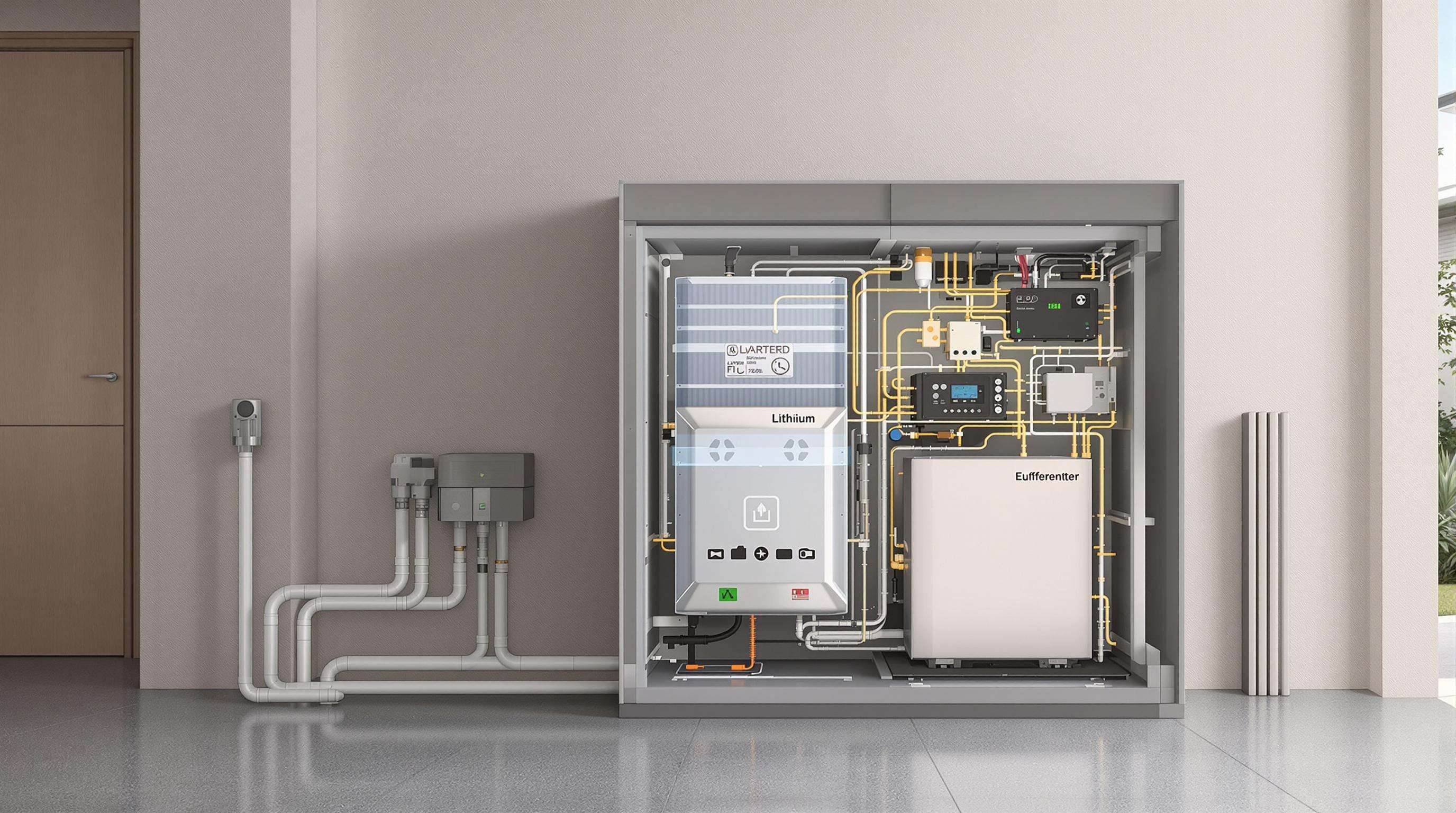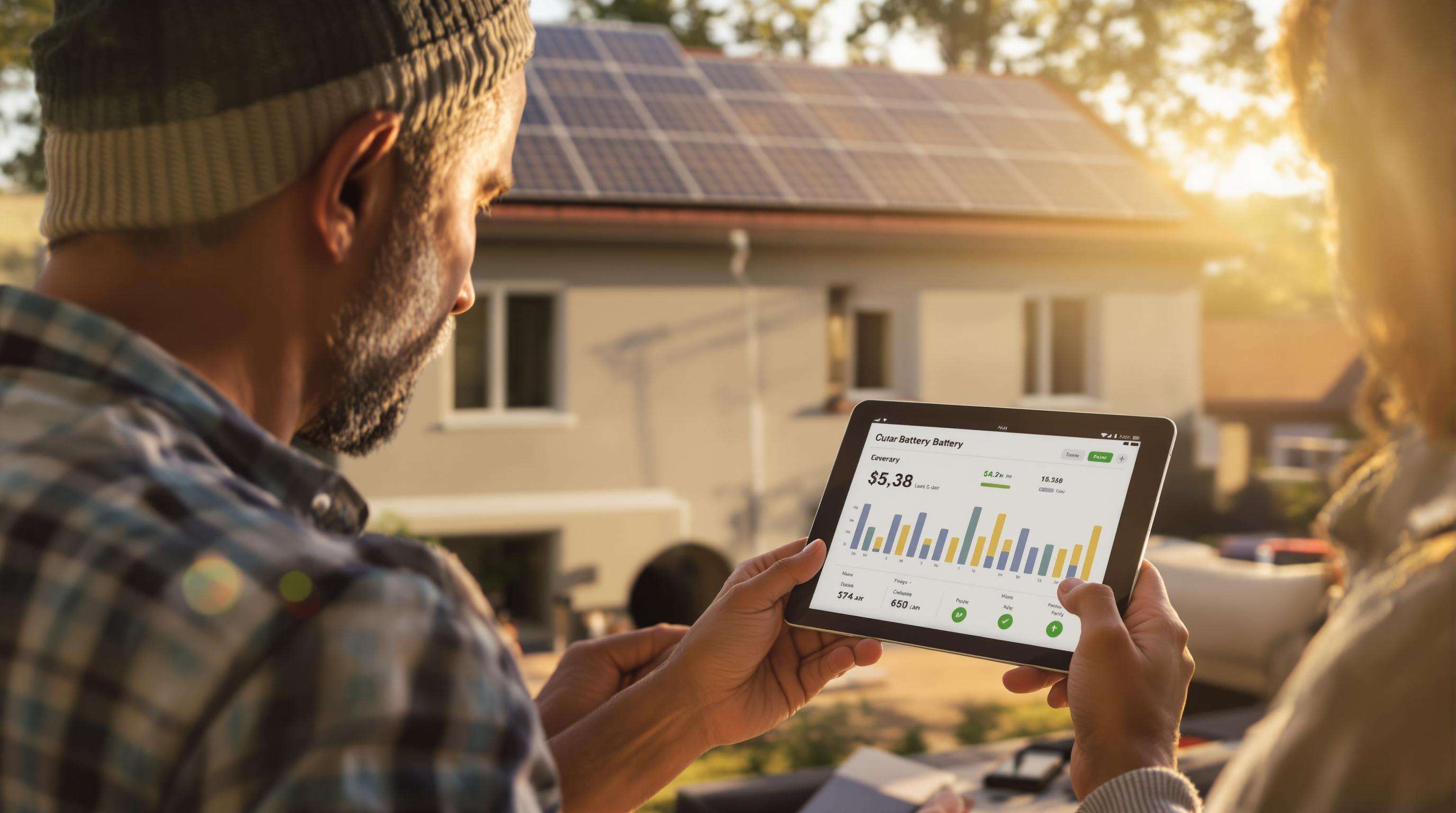الأنظمة المتكاملة للمحول والبطارية تجمع بين إنتاج الطاقة وتخزينها وتوزيعها في منصة موحدة واحدة. تعمل هذه الأنظمة على إزالة مشاكل التوافق بين المكونات مع تحسين تدفق الطاقة من خلال خوارزميات تحكم ذكية.
تجمع الأنظمة المتكاملة بين ثلاث مكونات رئيسية في صندوق واحد: عاكس هجين يقوم بتحويل الطاقة من التيار المستمر إلى التيار المتردد، وبطاريات ليثيوم لتخزين الكهرباء، ونظام إدارة البطارية (BMS) الذي يضمن تشغيل كل شيء بسلاسة. يمكن اعتبار هذا التكوين بمثابة مركز التحكم في حلول الطاقة المنزلية الحديثة. فهو يتعامل مع جمع الطاقة من الألواح الشمسية، والتواصل مع شبكة المرافق عند الحاجة، وتوفير الطاقة الاحتياطية أثناء الانقطاعات. تحتوي معظم العلامات التجارية الرائدة في السوق على جميع هذه المكونات مع شهادات سلامة من مختبرات المحققين (Underwriters Laboratories)، وتشمل اتصالاً بشبكة الواي فاي (Wi-Fi) مما يتيح لأصحاب المنازل مراقبة حالة النظام من أي مكان. بل إن بعض الشركات توفر تطبيقات هاتفية تعرض مقاييس تفصيلية عن الأداء مباشرةً على الهواتف الذكية.
عندما تُستخدم الألواح الشمسية مع أنظمة تخزين الطاقة، يمكن للمالكين فعليًا حفظ الكهرباء الزائدة التي تُنتج في منتصف النهار لاستخدامها في أوقات الذروة مساءً. هذا يقلل من كمية الطاقة التي يجب سحبها من الشبكة خلال تلك الفترات المكلفة. تلعب المحولات الكهربائية ثنائية الاتجاه دورًا أساسيًا أيضًا في هذه العملية. فهي تأخذ التيار المستمر الزائد الناتج عن الشمس وتحوله إلى تيار متردد قابل للاستخدام في الأجهزة المنزلية. وفي الوقت نفسه، تقوم هذه المحولات بشحن البطاريات أيضًا. بعض الأنظمة الأفضل المتاحة في السوق تحقق كفاءة تصل إلى نحو 92٪ في عملية التحويل هذه. وبحسب دراسات أجرتها جهات مثل مختبر الطاقة المتجددة الوطني في عام 2023، فإن المنازل التي تجمع بين الطاقة الشمسية والتخزين عادةً ما تستخدم ما بين 15 إلى 30 بالمئة إضافية من الطاقة التي تولدها بنفسها مقارنةً بالمنازل التي تعتمد على الطاقة الشمسية فقط دون تخزين.
تمكن المحولات الهجينة أربعة أنماط تشغيلية ضرورية للاستقلال في مجال الطاقة:
تحتوي الوحدات الحديثة على خصائص تشكيل الشبكة التي تحافظ على استقرار الجهد والتواتر دون الحاجة إلى دعم خارجي من الشبكة، وهو ما يُعد ضروريًا خلال فترات الانقطاع الطويلة. وتشجع الحوافز الاتحادية مثل خصم الضرائب البالغ 30% بموجب قانون خفض التضخم على اعتماد هذه التقنية، حيث ارتفعت عمليات تركيب المحولات الهجينة بنسبة 47% على أساس سنوي (وزارة الطاقة الأمريكية، 2023).

تتجه أنظمة تخزين الطاقة بعيدًا عن البطاريات التقليدية القائمة على حمض الرصاص نحو تقنيات الليثيوم أيون الأحدث مثل LiFePO4. يمكن لهذه البطاريات الحديثة أن تدوم حوالي 6000 دورة شحن وتصل كفاءتها إلى نحو 95 بالمئة أثناء الشحن والتفريغ. ما يجعلها أفضل هو ميزات التحكم في درجة الحرارة المدمجة فيها بالإضافة إلى تصميمها الوحدوي الذي يسمح للمستخدمين بتوسيع سعة التخزين تدريجيًا حسب الحاجة. يعني التحول إلى تقنية الليثيوم أن هذه الأنظمة أصبحت أخف بنسبة 60 بالمئة تقريبًا مقارنة بما كانت عليه، وهو أمر مهم جدًا للمالكين الذين يمتلكون مساحة محدودة على السطح أو مرآب صغير قد تكون فيه مثبتة الألواح الشمسية. إن الكثافة الطاقية الأعلى المدمجة في حزم أصغر ما هي إلا تغيير جذري لعديد من الاستخدامات السكنية.
تعمل العاكسات الهجينة كمركز تحكم للأنظمة الشمسية، حيث تجمع بين وظائف مثل تتبع MPPT الشمسي، والعمل مع الشبكة، وشحن البطاريات كلها في صندوق واحد. تصل معظم الموديلات الحديثة إلى كفاءة 95-98٪ تقريبًا عند تحويل الطاقة من التيار المستمر إلى التيار المتردد، مما يعني هدرًا أقل للطاقة في هذه العملية. ما يميز هذه الوحدات حقًا هو قدرتها على التبديل بسلاسة بين التشغيل المتصل بالشبكة والتشغيل الذاتي. تضمن هذه الميزة استقرار الإخراج الكهربائي حتى في حالة حدوث تغييرات غير متوقعة في كمية الطاقة التي تستهلكها الأجهزة المختلفة في أي لحظة.
يعمل نظام إدارة البطارية كعقلٍ أساسيّ للنظام بأكمله، إذ يتتبع معلوماتٍ مثل درجات حرارة كل خلية، وفروق الجهد بينها، وكمية الشحن المتبقية في كل منها. تستخدم هذه الأنظمة برامج ذكية لإدارة شحن البطاريات وتفريغها، مما يزيد من عمرها الافتراضي بنسبة 30% تقريبًا مع مرور الوقت. تأتي بعض الطُرز مزودةً بقدرات تعلم تُحسّن من قدرتها على مطابقة احتياجات الطاقة مع استهلاك المنازل المُعتاد على مدار اليوم. تتضمن معظم الأنظمة الحديثة الآن اتصال واي فاي وبلوتوث، ما يُتيح لأصحاب المنازل تعديل الإعدادات من هواتفهم عند الحاجة. هذا يُحوّل ما كان يُخزّن الطاقة إلى أداةٍ تُساعد بشكلٍ فعّال في إدارة استهلاك الطاقة في المنزل بكفاءةٍ أكبر.
تمكن أنظمة تخزين الطاقة الحديثة أصحاب المنازل من تخزين الطاقة الشمسية الزائدة خلال ساعات النهار لاستخدامها في الليل أو أثناء فترات الذروة. من خلال الجمع بين الألواح الكهروضوئية وبطاريات الليثيوم أيون، يمكن للأسر زيادة معدلات الاستهلاك الذاتي للطاقة الشمسية بنسبة تصل إلى 70% (NREL 2023)، مما يقلل من هدر الطاقة ويحسن استخدام الموارد المتجددة.
تقلل تكوينات الطاقة الشمسية الهجينة المدعومة بالبطاريات من الاعتماد على مزوّد الكهرباء من خلال إنشاء وسادة حماية ضد تقلبات أسعار الشبكة. يمكن لنظام تخزين الطاقة المنزلي النموذجي بسعة 10 كيلوواط ساعة أن يعوّض 60–80% من استهلاك الكهرباء في أوقات الذروة، مما يحقق وفورات سنوية تتراوح بين 1200 و1800 دولار أمريكي للمنازل في المناطق ذات التكلفة العالية مثل كاليفورنيا ونيو إنجلاند.

تحليل 2024 لـ 500 من مستخدمي أنظمة الطاقة الشمسية المدمجة مع البطاريات كشف عن:
| المتر | متوسط التحسن |
|---|---|
| الاعتماد الشهري على الشبكة | انخفض بنسبة 62% |
| الوفورات السنوية في فاتورة الكهرباء | 2100 دولار أمريكي لكل أسرة |
| حماية من الانقطاع | تغطية بنسبة 94% |
حقق أصحاب المنازل عائد استثمار كامل خلال 6 إلى 8 سنوات من خلال الجمع بين توفير الطاقة والحوافز الضريبية الاتحادية.
تحرم أنظمة تخزين الطاقة المتكاملة كل منزل من 7 إلى 10 أطنان متريّة من انبعاثات ثاني أكسيد الكربون سنويًا من خلال استبدال الطاقة المولدة من الوقود الأحفوري في الشبكة الكهربائية. وعند توسيع نطاق هذه التكنولوجيا على مستوى المجتمعات، فإنها تدعم الأهداف الأوسع للمناخ مع الحفاظ على موثوقية الطاقة السكنية.
تجمع الأنظمة الحديثة لتخزين الطاقة الكل في واحد بين دمج الطاقة الشمسية وتخزين البطاريات وإدارة الشبكة الذكية لتوفير طاقة غير متقطعة أثناء انقطاع التيار الكهربائي. تعمل هذه الحلول على التبديل التلقائي إلى الطاقة المخزنة في غضون جزء من الثانية من فشل الشبكة، مما يحافظ على تشغيل الأجهزة الأساسية وأنظمة التحكم المناخي.
تستخدم الأنظمة المتكاملة إدارة متقدمة للبطاريات (BMS) لتحديد أولويات الأحمال الحرجة مثل الثلاجات والأجهزة الطبية ومعدات الاتصالات أثناء انقطاع التيار الكهربائي. وعلى عكس المولدات التقليدية التي تتطلب تفعيلاً يدويًا، فإن هذه الأنظمة الآلية تحافظ على استمرار التغذية الكهربائية على مدار الساعة وتقلل الانبعاثات الكربونية بنسبة 60–80% مقارنةً بالبدائل التي تعمل بالديزل.
| مميز | أنظمة متكاملة | الأنظمة المودولارية |
|---|---|---|
| تعقيد التركيب | إعداد Plug-and-Play | أعمال كهربائية مخصصة |
| قابلية التوسع | سعة ثابتة | قابلة للتوسيع بوحدات إضافية |
| كفاءة المساحة | تصميم مدمج (∀ 6 قدم مربع) | تتطلب مساحة أكبر بنسبة 50–100% |
تتناسب الوحدات المتكاملة مع المنازل الحضرية التي تحتاج إلى نشر بسيط، في حين تخدم التكوينات النظامية بشكل أفضل الممتلكات الريفية ذات متطلبات الطاقة المتغيرة.
لقد شهدت المناطق المُعرَّضة للحرائق في كاليفورنيا والولايات المتضررة من الأعاصير على الساحل الشرقي للخليج نمواً بنسبة 210٪ في تركيب أنظمة الطوارئ الاحتياطية منذ عام 2022. حيث تُلغي الأنظمة المتكاملة مخاطر تخزين الوقود مع توفير 8 إلى 16 ساعة من الطاقة الأساسية خلال حالات الطوارئ الممتدة، وهو ما يتماشى مع إرشادات إدارة الفيدرالية لإدارة الطوارئ (FEMA) الخاصة بالاستعداد للكوارث فيما يتعلق بالمرونة في الطاقة السكنية.
تأتي أحدث المحولات الهجينة مزودة بتحسينات في خوارزميات تتبع نقطة القدرة القصوى (MPPT)، مما يعزز كمية الطاقة التي يمكنها استخلاصها من الألواح الشمسية. نحن نتحدث هنا عن تحسن في الأداء بنسبة تتراوح بين 8 إلى 12 بالمائة مقارنة بما كان متاحًا في عام 2020. لكن ما يميزها حقًا هي قدرتها على تشكيل الشبكة الكهربائية (Grid-Forming). يمكن لهذه الأجهزة أن تواصل التشغيل بشكل مستقل أثناء انقطاع التيار الكهربائي، لذا لم يعد أصحاب المنازل بحاجة إلى المولدات الصاخبة لتوفير الطاقة في حالات العزلة عن الشبكة. وبحسب بحث حديث أجرته شركة وود ماكينزي للطاقة والمتجددة (Wood Mackenzie Power & Renewables) في عام 2024، فإن معدلات اعتماد هذه التقنية في جميع أنحاء الولايات المتحدة قفزت بنسبة 38 بالمائة تقريبًا في العام الماضي فقط. الناس اليوم يريدون المزيد من التحكم في احتياجاتهم من الطاقة، وهو ما يفسر سبب شيوع حلول التخزين الذاتية كفاءةً في الوقت الحالي.
تُحقِّق المعمارية المُقترنة بتيار مباشر الآن كفاءة دورات شحن واستخدام بنسبة 97% من خلال تقليل خسائر التحويل بين الألواح الشمسية والبطاريات. تقوم منصات أنظمة إدارة البطاريات الموحّدة بتعديل دورات الشحن ديناميكيًا بناءً على توقعات الطقس وأنماط الاستخدام، مما يطيل عمر بطاريات الليثيوم أيون بنسبة 20%. تدعم هذه التطورات تكوينات الدعم الاحتياطي الكاملة للمنازل القادرة على دعم أحمال بقدرة 10 كيلوواط لمدة 24 ساعة أو أكثر.
يقوم المصنعون بمعالجة التحدي المتعلق بتكلفة المنتج مقابل متانته من خلال:
انخفضت أسعار الأنظمة المتكاملة بنسبة 22% منذ عام 2022، مع تقلص فترات استرداد الاستثمار إلى 6–8 سنوات في المناطق الغنية بالشمس.
تتكون الأنظمة المتكاملة من محول هجين لتحويل الطاقة من تيار مباشر إلى تيار متردد، وبطاريات ليثيوم لتخزين الطاقة، ونظام إدارة البطارية (BMS) لضمان التشغيل السلس.
تتيح المحولات الهجينة أربعة أوضاع تشغيل: الشحن الشمسي المتصل بالشبكة، والدعم الاحتياطي للبطارية خارج الشبكة، وتحسين أسعار استخدام الطاقة حسب الوقت، والتوافق بين المركبة والمنزل.
يسمح الدمج بحفظ الطاقة الشمسية الزائدة للاستخدام المستقبلي، ويزيد من كفاءة النظام، ويقلل الاعتماد على الشبكة خلال فترات الذروة.
توفر هذه الأنظمة طاقة كهربائية غير متقطعة من خلال التبديل التلقائي إلى الطاقة المخزنة في البطارية أثناء فشل الشبكة، مما يحافظ على تشغيل الأجهزة الأساسية وأنظمة التحكم المناخي.
 أخبار ساخنة
أخبار ساخنة2025-02-25
2024-11-27
2024-12-17